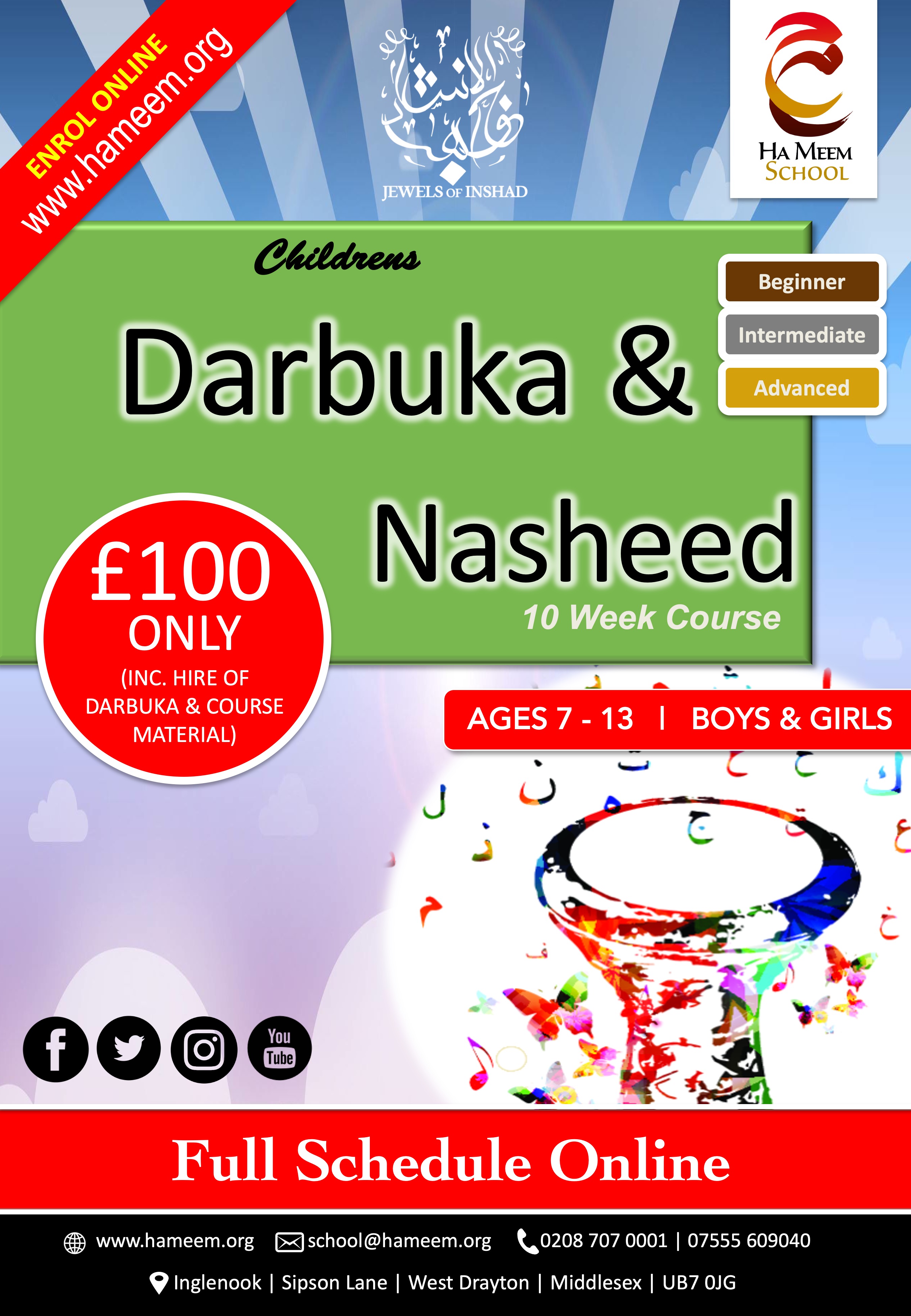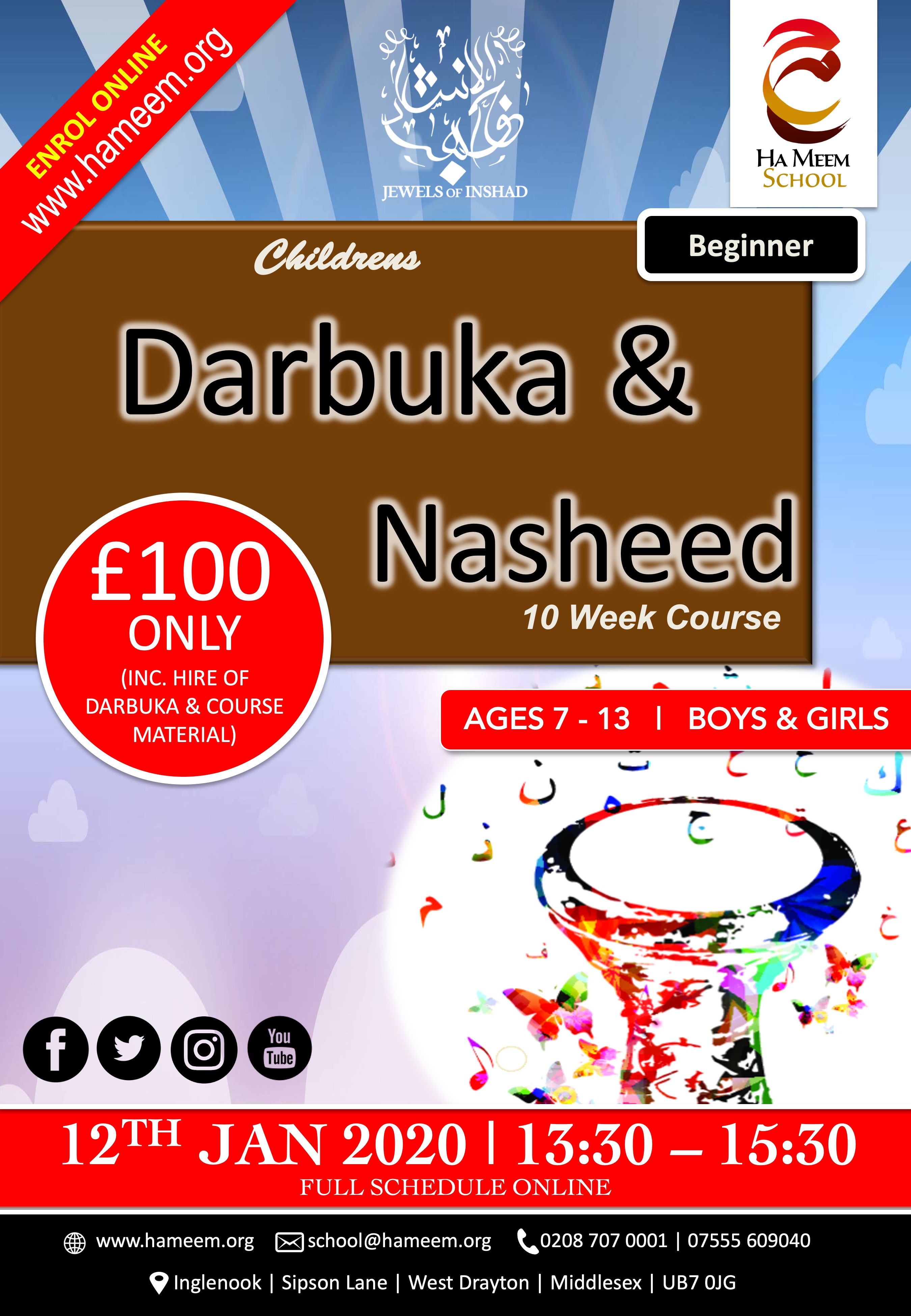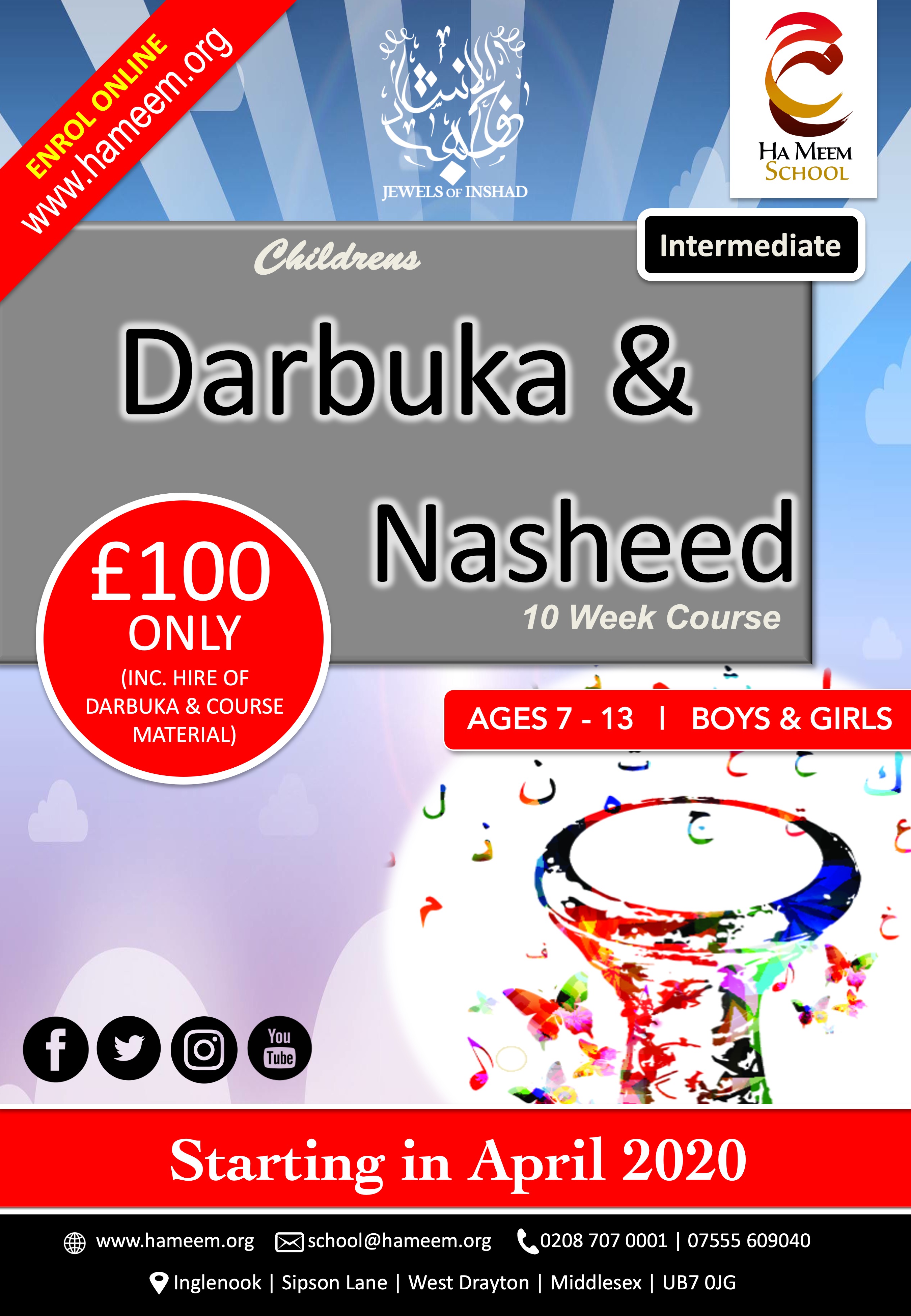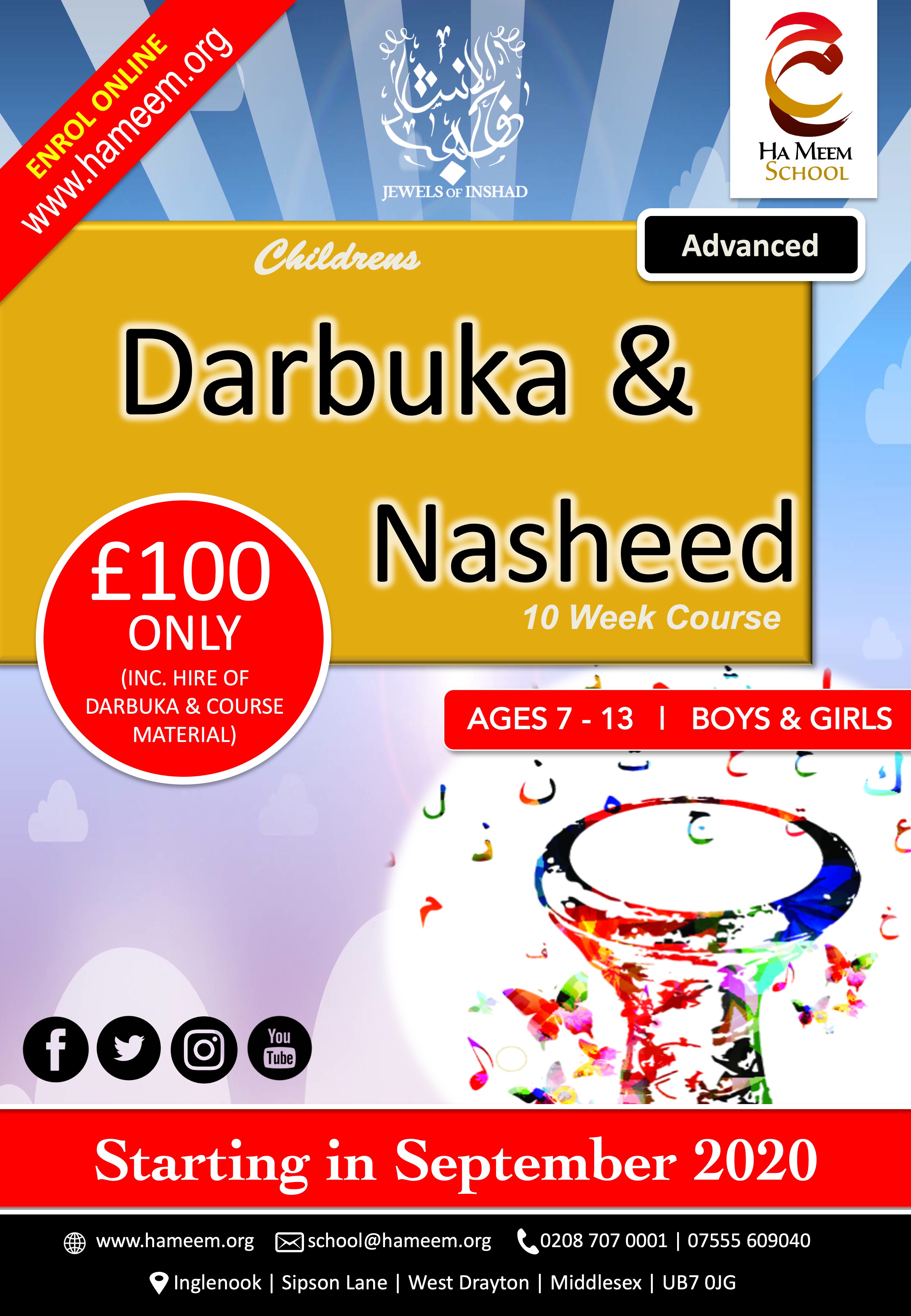
The Lote Tree Darbuka & Nasheed series is a complete programme that takes the beginner student to a high level of proficiency in the subject. The course is divided into 3 training levels, each lasting one term. Once the student has completed the three levels, they are invited to join the Lote Tree Munshideen Group, where they will train on a various range of more advanced drum rhythms and Islamic poems.
Each level consists of 10 lessons (inc performance). Homework will be set every week consisting of Darbuka practice exercises and Nasheed memorisation.
The training levels will aim to provide the basic skills necessary to start performing as part of the Lote Tree Munshideen Group. Students will become proficient with various popular Darbuka drum beats, and will gain exposure to popular Islamic Nasheeds. The Darbuka training element will cover stroke technique, various rhythm families and rhythm ornamentation. The Nasheed training will cover various vocal strengthening exercises, exposure to popular Nasheeds and a brief look at Maqamat theory.
Once students have completed the training levels, they will be invited to join the Lote Tree Munshideen Group, where we will have regular practice sessions to cover more advanced drum rhythms and Nasheeds. The aim for this group will be to get students in a position where they are comfortable performing in front of others and have string vocal control.
The course will be split into 2 parts: Darbuka training and Nasheed training.
The Darbuka training will aim to cover the fundamentals of playing a Darbuka, focusing on dominant hand stroke technique, basic rhythms and simple ornaments such as the “ka” technique. The fundamentals of these techniques will be established in the first half of the course, and the second half will aim to build on the fundamentals and focus on playing to accompaniment (with singing). The second half of the course will also start looking at “ornaments”, which are the use of small additional strokes to add to the main rhythm.
The Nasheed training will aim to cover some key foundational singing techniques through vocal strengthening exercises and an exploration of various Arabic poetic meters. The first half of the course will aim to build vocal strength using a rhythm from the Ajam Jaharka style of the Qasidah Al Burdah, and the Sika style of Tala Al Badru Alayna. This half of the course will be acapella (purely vocal), with no Darbuka used in the Nasheed training section. The second half of the course will look to consolidate the previously learn Nasheeds, but this time using a Darbuka to accompany the singing. Students will take turns to play Darbuka to the accompaniment of the song, to build their Darbuka skills.
The course will be split into 2 parts: Darbuka training and Nasheed training.
The Darbuka training will aim to build on the basic Darbuka fundamentals covered in the Level 1 course. This course will focus on incorporating the “Ka” technique, using ornaments such as the “Rizz” and generally expanding on the rhythms learnt. Rhythms that will be covered include Sa’idi 1 & 2, Ayub 1 & 2 and a basic introduction to the Malfuf. The Level 2 course will also incorporate more accompaniment: students will take it in turns over the course to get exposure to playing Darbuka to accompany singing. This will build their rhythmic skills as it will allow students to get used to hearing their drum in a smaller mix, and hence improve their skills of keeping in rhythm and maintaining correct stroke technique.
The Nasheed training will aim to build on the skills gained in the previous course. There will be a large focus on vocal techniques throughout the course as the students get used to singing more confidently. A number of Nasheeds from different poetic meters will be used to help the students practice. The Nasheeds covered will include Qasidah Al Burdah (a more ornamented version of the previously learnt rhythm), Qad Kaffani (a completely different rhythm, albeit in the same poetic meter) and an English Nasheed by Maher Zain, Assalamu Alayka. The vocal techniques covered will include breath control, pitch control, and use of ‘urba (vocal shaking) when singing.
The course will be split into 2 parts: Darbuka training and Nasheed training.
The Darbuka training will introduce more ornamentation to student’s playing. They will gain exposure to more elaborate techniques that will enhance their Darbuka skills and enable them to really come into their own as drummers. We will incorporate advanced “bridge” techniques, fast rolls, the “rizz” techniques and the “slap” technique into the student’s playing styles in order for them to grow their repertoire. By this stage, students should be familiar with basic accompaniment, and as such will start working on more advanced accompaniment techniques, such as changing the rhythm being played according to the singer’s style.
The Nasheed training will aim to build on the skills gained in the previous course. There will be a large focus on vocal techniques throughout the course as the students get used to singing more confidently. A number of Nasheeds from different poetic meters will be used to help the students practice. The Nasheeds covered will include Qasidah Al Burdah (a different set of rhythms than those that were previously covered), Talama Ashku Gharami and Ya Abaa Zahra in the Persian poetic meter, Nahwand, and an English Nasheed by Ibraheem Malik, Echoes of Persia. The vocal techniques covered will include breath control, pitch control, and use of ‘urba (vocal shaking) when singing.
These sessions will be regular and planned according to upcoming performances and individual student targets.
Courses
“Outstanding facility for the community that caters for all age groups. Conducive learning environment. Dedicated staff and volunteers. Long may it continue.”
“MashAllah an amazing space to learn!”
“Simply superb.. Something for everyone, a real asset to our local community.”
“Excellent organisation offering a good range of services”
Necessary place of direction, belonging, purposes. This will be remembered for where it began for West London
“My kids attend the madrasah despite having another place closer. My kids love it here so would not look to change. Teachers have been very patient with them both.”
“Masha’Allah, a great environment for children to learn. Lote Tree School has excellent classrooms and facilities.”
“The teachers at Lote Tree School takes great pride in teaching my children Qur’an using Tajweed coupled with the personal touch that goes a long way. My children love it here!”
“Deep, insightful, and inspiring course on a wrongly-neglected subject.”
“Excellent facilities include ample parking nearby and open garden space. Staff are very professional and endeavour to cater for everyone from the toddlers to the elderly.
Especially grateful for the live stream facilities, I don’t miss out on the great talks if I can’t make it to Sipson. Excited to see what else they offer this coming year.”



